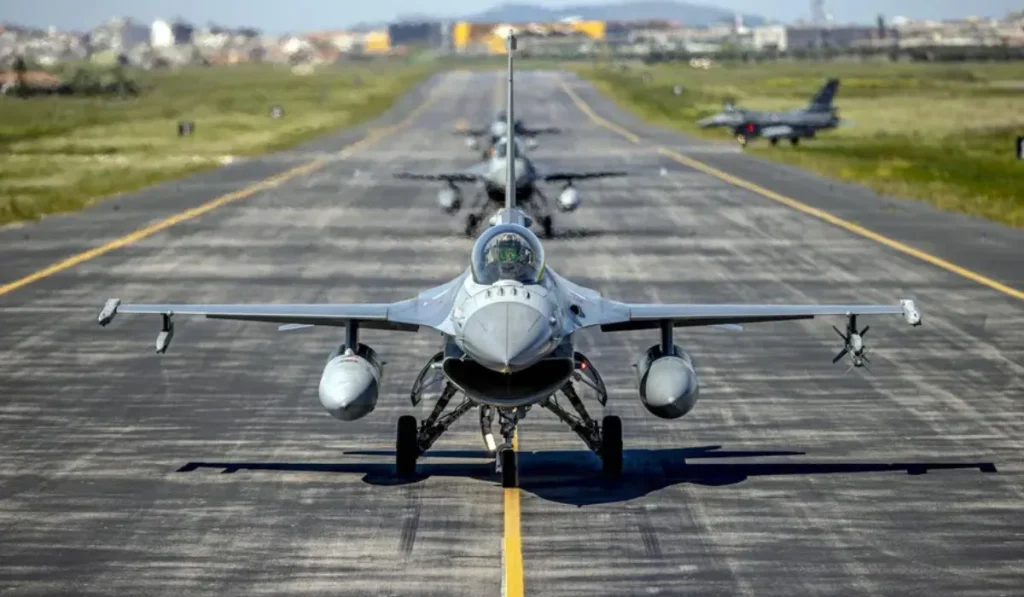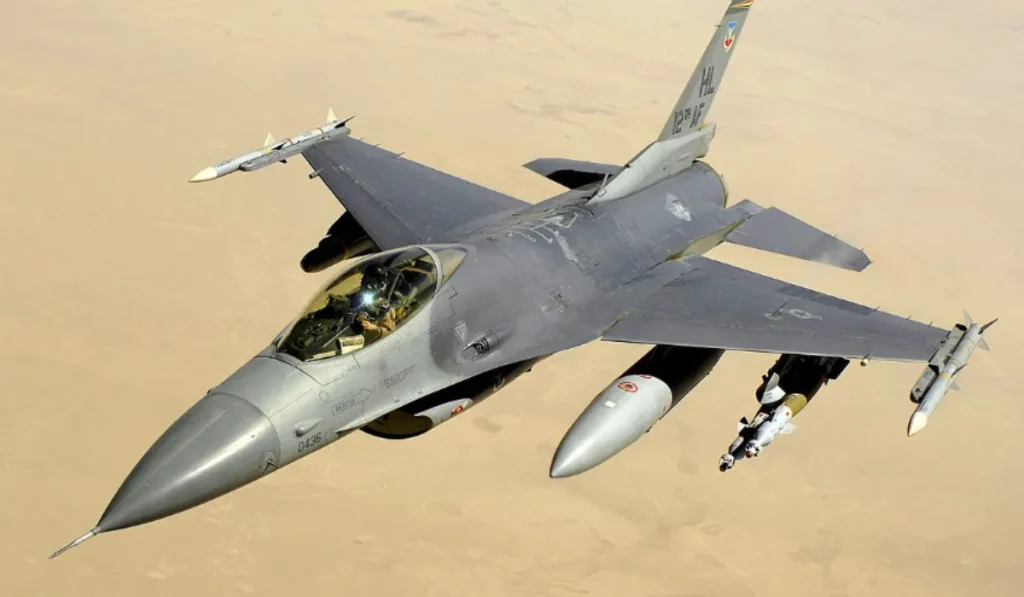An F-16 Fighting Falcon has an empty weight of approximately 18,900 pounds. Its maximum takeoff weight is about 42,300 pounds.
The F-16 Fighting Falcon, known for its agility and versatility, serves as a staple in many air forces around the globe.
This lightweight fighter jet, designed by General Dynamics, now Lockheed Martin, excels in numerous roles, including air superiority, ground attack, and electronic warfare.
Pilots favor the F-16 for its incredible maneuverability and advanced aerodynamic design, which enables it to maintain control at high G-forces.
Commonly referred to as the “Viper” by its pilots, the F-16 has a distinguished combat record, having been actively engaged in numerous conflicts since its introduction in the late 1970s.
The combination of its low procurement and operational costs, compared to other fighters in its class, ensures the F-16 remains a cost-effective and powerful asset for air forces.
The F-16 Fighting Falcon: An Introduction
The F-16 Fighting Falcon soars through the skies as a marvel of modern engineering. Known for its speed, agility, and precision, it is a force to reckon with.
The F-16’s impressive capabilities and lightweight design have carved out its position as one of the most successful fighter jets in the air force’s arsenal. In the realm of combat aircraft, few can match its reputation and performance.
Birth Of An Icon: History And Development
The F-16, developed by General Dynamics in the 1970s, was born out of the need for a versatile and cost-efficient air-to-air fighter.
As a product of the Lightweight Fighter Program, the F-16 overcame intense competition to become the fighter of choice for the US Air Force. Its development heralded a new era in fighter technology.
- Initial conception in 1971, arising from the demand for a lightweight aircraft.
- Prototype’s maiden flight in early 1974, showcasing potential.
- Introduced to the USAF in 1978, revolutionizing aerial combat.
Roles And Missions: The F-16’s Versatility
The F-16 Fighting Falcon fulfills multiple roles, proving its exceptional adaptability. Originally designed as an air superiority day fighter, it evolved into a successful all-weather multirole aircraft. The F-16 excels in various missions:
| Role | Capabilities |
|---|---|
| Air Combat | Engages enemy aircraft with precision. |
| Ground Attack | Delivers precise munitions for ground targets. |
| Electronic Warfare | Disrupts enemy systems with advanced technology. |
| Reconnaissance | Gathers critical intelligence from the sky. |
Delving Into The Design

An exploration into the F-16 Fighting Falcon reveals a marvel of modern engineering. This lightweight fighter, known for its agility in the sky, owes its superior performance to a meticulous design process.
Understanding its design requires a look at both its aerodynamics and material composition. Let’s delve into what makes an F-16, not just a fighter jet, but a sensation in the world of aviation.
Engineering Marvel: Aerodynamics And Structure
The F-16 stands out due to its aerodynamic excellence. Its engineers focused on a design that offers remarkable maneuverability and speed. Key features include:
- Lightweight airframe: Reduces drag and increases speed.
- Streamlined contours: Enhances the jet’s ability to slice through the air.
- Fly-by-wire control system: Allows for precise movements in the sky.
The F-16’s structure boasts a frame that supports not just its own weight but also the stresses of combat maneuvers. The aircraft typically weighs approximately 9,200 kg empty and can take off at weights up to 19,187 kg.
Material Matters: Composition Of An F-16
The right materials are critical for performance. An F-16 comprises:
| Material | Percentage | Function |
|---|---|---|
| Aluminum | 80% | Primary structure |
| Steel | 8% | Engine and landing gear |
| Titanium | 7% | Fuselage frames |
| Other materials | 5% | Various parts |
The use of aluminum, vital for a light yet sturdy airframe, plays a dominant role in the F-16’s design, while steel and titanium reinforce critical sections of the aircraft.
Understanding The Weight Metrics

Understanding the weight metrics of an F-16 is crucial for both aviators and military enthusiasts. It helps in grasping the jet’s design and capabilities. Let’s dive into these metrics.
Empty Weight: The Core Of The Falcon
The empty weight of an F-16, also known as the aircraft’s weight without any fuel or payloads, is fundamental to its structure. It reflects the jet’s efficiency and agility.
- Lightweight construction materials
- Aerodynamic design for optimal performance
- Weight influences speed and fuel consumption
Max Takeoff Weight: The Full Potential
An F-16’s max takeoff weight showcases what the jet can carry. This includes the full load of fuel, weapons, and any additional gear necessary for diverse missions.
| Component | Weight Contribution |
|---|---|
| Fuel | Varies by mission |
| Weapons | Diverse depending on armaments |
| Cargo | Additional gear for specific operations |
Operational Loadout And Its Impact
Understanding the operational loadout of an F-16 Fighting Falcon reveals how its weight affects performance. The loadout includes weapons, fuel, and external tanks, which are crucial for missions.
It is a balance of firepower and aerodynamics. The right mix allows a pilot to achieve mission goals effectively.
Standard Armament Weight: A Pilot’s Arsenal
A loaded F-16 is ready for any threat. Its arsenal is a mix of guns, missiles, and bombs. Each piece adds to the total weight.
- M61 Vulcan cannon: A lightweight rapid-fire weapon.
- Air-to-air missiles: Sidewinders and AMRAAMs for dogfights.
- Air-to-ground ordnance: Precision bombs tackle ground targets.
This selection allows for adaptability. The weight of these weapons is critical for handling and speed. Thus, pilots must choose wisely.
Fuel And External Tanks: Balancing Performance
Fuel is vital for an F-16’s range and mission time. Fuel load must match the mission requirements. More fuel means longer air time but reduced speed and agility.
| Fuel Type | Weight | Impact on Performance |
|---|---|---|
| Internal Fuel | 7,000 pounds | Less drag, better speed |
| External Tanks | Up to 12,000 pounds | More range, less maneuverability |
Pilots must find a balance. The plane can carry both internal and external fuel. Drop tanks provide extra fuel but can be jettisoned. This allows for weight adjustment mid-flight.
Comparative Analysis With Contemporary Fighters
Exploring the weight of fighter jets is vital for understanding their performance and capabilities.
In this comparative analysis with contemporary fighters, we delve into how the F-16 Fighting Falcon measures up against its modern counterparts. By comparing the weight and the implications for speed, agility, and load capacity, we gain insight into the continual evolution of these impressive aircraft.
F-16 Vs. Its Peers: A Weighty Consideration
The F-16 Fighting Falcon, known for its remarkable maneuverability and advanced technology, tips the scales at an approximate empty weight of 18,900 pounds (8,570 kilograms). To understand this in perspective:
- Boeing F/A-18 Super Hornet: Stands heavier at around 32,000 pounds (14,500 kilograms) empty weight.
- Lockheed Martin F-35 Lightning II: Weighs in at about 29,300 pounds (13,300 kilograms) without fuel or armaments.
- Saab JAS 39 Gripen: Comes in lighter, with an empty weight of roughly 16,535 pounds (7,500 kilograms).
Each jet has distinct design philosophies and weight allocations affecting speed, range, and payload capabilities.
Progression In Weight And Power
From the early days of the biplane to the sleek jets of today, fighter aircraft have undergone a significant transformation. This evolution reflects a balance between weight increase and power improvement. Notably:
| Generation | Average Weight Increase | Power Improvement |
|---|---|---|
| 1st Gen | Light weight | Modest power |
| 2nd Gen | Moderate increase | Improved engines |
| 3rd Gen | Heavier frames | Advanced propulsion |
| 4th Gen (F-16) | Optimized weight | High-performance engines |
| 5th Gen | Stealth materials | Superior power |
The F-16 exemplifies optimization, balancing heft and horsepower to achieve its renowned status. Current trends show fighters evolving with materials and technology that push the envelope in aviation science, witnessing incremental weight gain paired with significant power boosts.
The Weight Behind The Warfighter
F-16 fighter jets represent air power and precision. Understanding an F-16’s weight is vital for performance. It assures optimal combat operation. F-16 jets can weigh around 20,300 pounds without fuel or armaments.
Depending on the mission, this weight can change significantly. The weight impacts numerous aspects of an F-16’s operational capacity.
Weight Constraints In The Field
- Weight affects takeoff: Heavier jets need longer runways.
- Maneuverability: Lighter jets turn tighter in dogfights.
- Weight dictates payload: More weapons mean more weight.
- Fuel efficiency: Heavier jets use more fuel.
Each F-16’s mission defines its loadout. Missions require a delicate balance between fuel, armaments, and range. Too much weight reduces performance and effectiveness.
Maintenance And Upkeep: The Heft Of Readiness
Keeping F-16s ready involves managing their weight. Mechanics must consider the weight of each part they replace. Ground crews play a critical role in weight management.
| Task | Weight Consideration |
|---|---|
| Engine maintenance | Each engine component adds to overall weight |
| Armament loading | Choice of weapons influences jet’s agility |
| Fuel management | Fuel weight alters for different missions |
Maintenance checks ensure every F-16 jet remains within safe weight limits. Every component matters. The exact weight helps the jet to fly right. It’s a matter of safety and efficiency.
FAQs About the Weight of An F 16
What Is The Weight Of An F-16 Fighter Jet?
The typical weight of an F-16 fighter jet is approximately 20,000 pounds when empty. With a full load of fuel and armaments, it can weigh up to 48,000 pounds.
How Does An F-16’s Weight Affect Its Performance?
An F-16’s performance is highly sensitive to its weight. Lesser weight improves agility and speed, while a heavier load extends its range and payload capacity for missions.
Can An F-16’s Weight Vary During Flight?
Yes, an F-16’s weight varies during flight. As it consumes fuel and expends munitions, its weight decreases, potentially enhancing its flight performance and maneuverability.
What Is The Maximum Takeoff Weight Of An F-16?
The maximum takeoff weight of an F-16 is around 42,300 pounds. This includes the weight of the aircraft plus its maximum fuel and munitions load.
Conclusion
Understanding the weight of an F-16 is crucial for appreciating its agility and performance.
This fighter jet tips the scales at about 20,300 pounds empty, with operational capabilities impacted by its loadout. As we’ve explored, variations exist across models and configurations.
Remember this detail when considering the F-16’s role in modern air forces. Continue your aviation knowledge journey with us for more insights.
Resources:
https://www.af.mil/About-Us/Fact-Sheets/Display/Article/104505/f-16-fighting-falcon/
